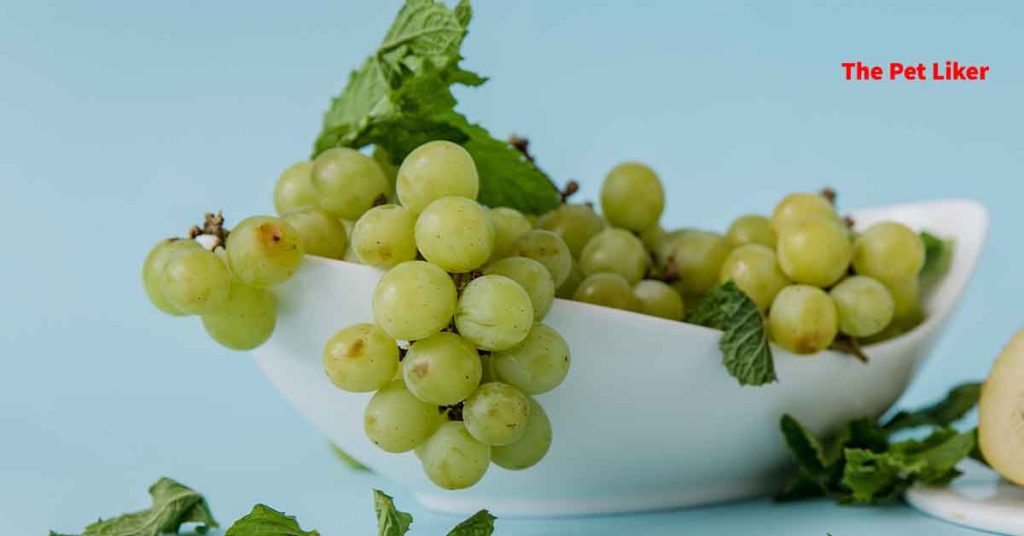Guinea pigs are popular pets known for their adorable appearance and their love for fresh fruits and vegetables.
While guinea pigs can eat a variety of fruits, it’s important to know which ones are safe and healthy for them. One fruit that many guinea pig owners may wonder about is green grapes.
In this article, we’ll explore whether guinea pigs can eat green grapes, their nutritional benefits and risks, and how to incorporate them into your guinea pig’s diet.
The Nutritional Value of Green Grapes
Green grapes are a great source of many essential vitamins, minerals, and other nutrients that are important for maintaining good health. Here are some of the key nutritional benefits of green grapes:
- Vitamin C: Green grapes are a good source of vitamin C, which is an important antioxidant that helps protect the body from damage caused by harmful free radicals.
- Fiber: Green grapes are a good source of dietary fiber, which can help improve digestion and reduce the risk of constipation and other digestive problems.
- Potassium: Green grapes are a good source of potassium, which is an important mineral that helps regulate blood pressure and supports healthy heart function.
- Resveratrol: Green grapes contain resveratrol, which is a powerful antioxidant that has been linked to a reduced risk of heart disease, cancer, and other chronic diseases.
- Vitamin K: Green grapes are a good source of vitamin K, which is important for blood clotting and bone health.
- Other nutrients: Green grapes also contain small amounts of other important vitamins and minerals, including vitamin B6, thiamine, riboflavin, and magnesium.
Can Guinea Pigs Eat Green Grapes?
Yes, guinea pigs can eat green grapes, but only in moderation. Green grapes are a good source of vitamin C, which is essential for guinea pigs because, like humans, they cannot produce it naturally and must get it through their diet.
Vitamin C plays an important role in maintaining a healthy immune system, skin, and bones.
Green grapes are also high in sugar, which can cause digestive problems if consumed in large quantities.
Too much sugar in a guinea pig’s diet can lead to obesity, dental issues, and other health problems.
It’s essential to provide a variety of fruits and vegetables in moderation to ensure a balanced and healthy diet for your guinea pig.

Are Green Grapes Safe For Guinea Pigs?
Green grapes are generally safe for guinea pigs, but as with any new food, it’s essential to introduce them gradually and in moderation.
Guinea pigs have sensitive digestive systems, and sudden changes in their diet can cause stomach upset or diarrhea.
It’s important to remove the seeds from green grapes before feeding them to your guinea pig, as they can be a choking hazard.
The skin of grapes can be tough to digest for some guinea pigs, so it’s a good idea to peel them before feeding.
While green grapes do offer some nutritional benefits, they are also high in sugar. Overfeeding grapes or any fruit can lead to obesity and other health problems in guinea pigs.
A small amount, such as one or two grapes per week, is sufficient for your guinea pig to enjoy as a treat.
Benefits ✅
Green grapes offer several nutritional benefits for guinea pigs. Here are some of the benefits of feeding green grapes to your guinea pig:
- Rich in Vitamin C: Green grapes are a good source of vitamin C, which is essential for guinea pigs as they cannot produce it naturally. Vitamin C plays an important role in maintaining a healthy immune system, skin, and bones.
- Source of Vitamin K: Green grapes contain vitamin K, which is important for blood clotting and bone health.
- Good source of Potassium: Potassium is an important mineral that helps regulate fluid balance, muscle contractions, and nerve function. Green grapes are a good source of potassium.
- Antioxidants: Green grapes contain antioxidants, such as resveratrol, which can help protect cells from damage and reduce inflammation.
- Hydration: Green grapes are rich in water content, which can help keep your guinea pig hydrated.
- Variety in Diet: Adding green grapes to your guinea pig’s diet can provide variety and enrichment, making mealtimes more enjoyable.
Risks ❌
While green grapes offer some nutritional benefits for guinea pigs, there are also some risks associated with feeding them to your furry friend. Here are some of the risks of feeding green grapes to guinea pigs:
- High Sugar Content: Green grapes are high in sugar, and overfeeding them to your guinea pig can lead to obesity and other health problems, such as dental issues.
- Choking Hazard: The seeds of grapes can be a choking hazard for guinea pigs, so it’s essential to remove them before feeding grapes to your pet.
- Tough Skin: The skin of grapes can be tough to digest for some guinea pigs, leading to digestive upset or diarrhea.
- Allergic Reactions: Some guinea pigs may be allergic to grapes or develop an intolerance to them, leading to symptoms such as itching, swelling, or respiratory distress.
- Interference with Medications: Grape seeds and skin contain compounds that can interfere with certain medications, so it’s best to consult with your veterinarian before feeding grapes to a guinea pig that is taking any medication.
Servings 🍽️
When serving green grapes to your guinea pig, it’s essential to prepare them properly to ensure they are safe and easy to digest. Here are some tips on how to serve green grapes to your guinea pig:
- Wash thoroughly: Before serving green grapes to your guinea pig, make sure to wash them thoroughly with clean water to remove any dirt or pesticide residue.
- Remove the stem: Cut off the stem of the grape, as it can be tough to chew and swallow.
- Remove the seeds: Guinea pigs can choke on grape seeds, so it’s essential to remove them before feeding. Cut the grape in half and use a small spoon or knife to scoop out the seeds.
- Peel the skin: The skin of grapes can be tough to digest for some guinea pigs, so it’s a good idea to peel them before feeding. Alternatively, you can slice the grape in half and let your guinea pig nibble on the flesh, leaving the skin behind.
- Offer in moderation: Green grapes are high in sugar, so it’s important to offer them in moderation as a treat, rather than as a staple in your guinea pig’s diet. One or two grapes per week are sufficient.
- Introduce gradually: As with any new food, it’s essential to introduce green grapes gradually to your guinea pig’s diet, starting with a small piece and monitoring for any signs of digestive upset.
By following these tips, you can safely serve green grapes to your guinea pig as an occasional treat.
Wrapping Up
Hope this article answered your question “Can guinea pigs eat green grapes?”
Green grapes can be a nutritious and tasty addition to your guinea pig’s diet when offered in moderation and prepared properly.
Green grapes are a good source of vitamin C, vitamin K, and potassium, as well as antioxidants.
They are also high in sugar and can be a choking hazard if the seeds are not removed. It’s essential to wash the grapes thoroughly, remove the stem and seeds, and peel the skin before serving to your guinea pig.
Remember to offer green grapes as an occasional treat and introduce them gradually to your pet’s diet.
A balanced diet that includes a variety of fresh fruits and vegetables is the best way to ensure your guinea pig’s health and well-being.
Thank you for reading! Always stay with The pet liker!! Have a nice day!!!
FAQS
Here are some frequently asked questions about feeding green grapes to guinea pigs:
Q: Can guinea pigs eat red grapes?
A: Yes, guinea pigs can eat red grapes as well as green grapes. However, the same precautions should be taken as with green grapes, including removing the seeds and peeling the skin before serving.
Q: How often can guinea pigs eat grapes?
A: Green grapes and other fruits should be offered to guinea pigs in moderation as a treat, rather than a staple in their diet. One or two grapes per week is sufficient.
Q: Can guinea pigs eat grape leaves?
A: While grape leaves are safe for guinea pigs to eat, they are not very nutritious and can be tough to digest. It’s best to stick with fresh fruits and vegetables as a source of nutrients for your guinea pig.
Q: Can grapes cause diarrhea in guinea pigs?
A: Feeding too many grapes to your guinea pig can lead to digestive upset or diarrhea, especially if the seeds and skin are not removed. It’s essential to introduce new foods gradually and observe your guinea pig’s behavior and digestive health.
Q: Are grapes safe for baby guinea pigs?
A: Baby guinea pigs have delicate digestive systems and should not be fed any fruits or vegetables until they are at least four weeks old. Even then, it’s essential to introduce new foods gradually and monitor for any signs of digestive upset.


1 thought on “Can Guinea Pigs Eat Green Grapes”
Comments are closed.